Car Trek
To Boldly go where no Charger has gone before.
By Jim Koscs Photos by TheBruntBros
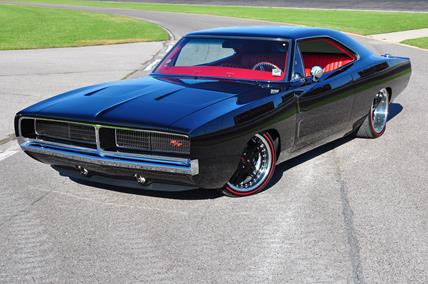
Six months of smoothing and block sanding make this custom Charger one of the straightest cars we’ve ever seen without our glasses. Every body panel except the roof has been reworked, yet the B-body still retains all its classic persona.
Tom Boldry proudly points out that the only body part left unmodified on his 1969 Charger is the roof. That makes it a lot like a facelift of another 1969 classic — Cher.
The ’68 Charger taillights are actually one of the smaller changes to this car, and we point them out only so you don’t freak out and go, “Hey, that’s not a ’69!” We also want to get out up front that we think Boldry’s Charger is among the best customs we’ve ever seen since last Tuesday. Customizing a second-gen Charger by altering all of its body panels could have gone the other way … and it has, as you have seen even in this magazine.
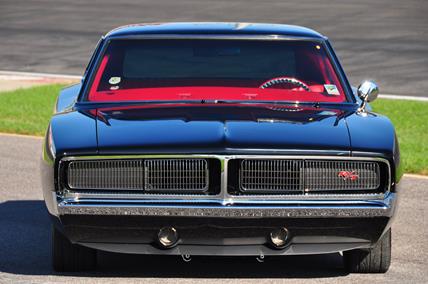
The front end is virtually hand made and lowered 2 inches. The bumper is scratch-built. Air intake is slots below the turn signals.
What possessed Boldry to go all-out custom? Stop us if you’ve heard this one before, but Boldry says the whole project started out as a new K-frame and one thing led to another. That’s like this magazine. It all started many years ago as a simple letter to Lee Iacocca suggesting Chrysler add a padded vinyl roof and landau bars to create a new model–the Dodge Omni Brougham. One thing led to another and, before you know it, Mopar Action was a real magazine. (Or a pretty good imitation.)
Getting back to Boldry’s Charger, though, the next thing he knew, the retirement money was channeled into something more fun, but perhaps less useful for buying things such as food. But Boldry wasn’t worried. This one-of-a-kind Charger was personal payback to himself for enduring taunts in high school from friends who drove cool Mopars while he drove a VW.
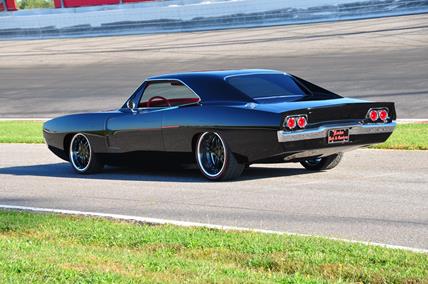
Charger has a great stance. Rear bumper is heavily modified, and this ’69 wears ’68 taillights. Rear suspension is a 4-link with coilovers. The project started with a restored 440 Charger R/T SE.
Some of you might not like to read this, but Boldry did not start this project with a plain Jane 318 Charger. Nosiree. He started with a restored R/T SE that had a non-numbers matching 440. He figured a 472 Hemi crate motor would liven things up. The resto was “good,” but there were “issues” in the floor and rear window and taillight pan. Since he preferred the ’68 lights anyway, that decision was easy. And then the cutting and welding just kept going for over two years—until he ran out of welding rods and acetylene gas. The Hemi swap was going to require a new K-frame, so Boldry decided on a whole Magnum Force front end. Why not ditch the original automatic for a Keisler 5-speed while he was at it? After all, Shafi Keisler needs the dough to finance his own project ’Kuda (as described in Mopar Action’s 119-part series).
“It took off from there,” Boldry says. And so did his credit card balance – along with a 1970 Lemon Twist Road Runner sold to help finance this car.
Let’s start where it all began, at that Hemi swap. Even that was just a jumping-off point. As you can see, this is no ordinary crate motor. Jason Rock of Rock’s Rod and Custom in Independence, MO built the Charger, and he crafted that wild looking polished aluminum intake tract. Yes, it’s a single piece– tubes and all. The centerpiece is a blower hat turned backward. The system feeds a Mass-Flo injection system, pulling in air from a big custom airbox mounted behind the front valence. Air enters through slots below the turn signals.
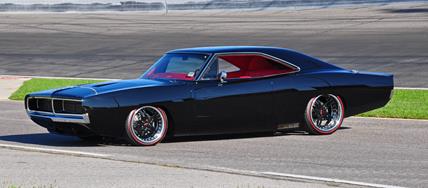
The K-frame required relocating the front wheelwells. They are pulled back 1-1/2 in. the quarters care handmade from the beltline down. The wheelwells are reshaped to follow the wheel contour. Exhaust is integrated into the custom rockers.
The rest of the Hemi is no less impressive, with aluminum heads and intake from Indy Cylinder Heads, roller rockers and domed pistons. The engine made 675 horses on an engine dyno but has not yet been on a chassis dyno or in San Francisco.
As you can see, all you can see in the engine bay is a tight view of the Hemi. It almost looks like one of those Revell or AMT scale models built the “custom” way, but only bigger. Rock made the inner fender panels and hid just about everything not needed for visual appeal.
Sanderson headers exit into a 3-inch exhaust system that then exits through unique side-exhaust ports notched into the custom rocker panels. But those are only for the Quicktime Performance electric cutouts. There’s also a full dual exhaust system, with Flowmaster mufflers, exiting at the rear. You just can’t see it.
The original rear suspension was replaced by a custom 4-link with QA1 coilovers, and the frame rails have been notched four inches to go with the 2-inch drop in front. The rear is a Miller Brothers 9-inch with an Eaton Detroit TrueTrac differential packing a mild 3.25 gear for easy highway cruising. He has 4.10s on the shelf for difficult highway cruising.
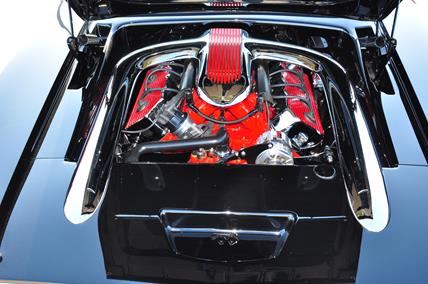
Now, this is really different. Polished aluminum tubes channel intake air from an airbox behind the front valence to a backward blower hat. Crate 472 Hemi is showcased by the inner fender covers.
Brakes are Wilwood, and the Boze ZE forged “Friction” wheels earned Boldry’s car a starring role on the Boze website. The wheels are huge, and that brings up one of the key reasons why this car looks so hot. As the better custom Chargers have clearly shown, this body style begs to be lowered, with huge alloys stuffed into the wheel wells. Done well (as on this car), it makes a stock Charger sitting on its tiny 14-inchers and 70-series tires look a little wobbly.
With the resulting stance, the Charger takes on a trait that makes some people go nuts for exotics like a Lamborghini (a brand that Chrysler once owned – remember those carefree cash-machine days?) It’s a look that comes from a taut body seemingly wrapped around its wheels, which on Boldry’s car measure 18 x 8 in. front with 225/40R18 Nitto tires and 20 x 10 in. rear with 285/35R20s. The “R/T” wheel center caps are custom-made, and the tire redline was applied by DiamondBack.
That “wrapped around the wheels” stance is accentuated by widened rear quarters, which were cut and totally remade from the belt line down. These blend seamlessly (literally) into the custom rockers. Door handles and other exterior bits were shaved, but we’re glad Boldry kept the Charger’s flip-up gas cap. (See? We’re easy to please).
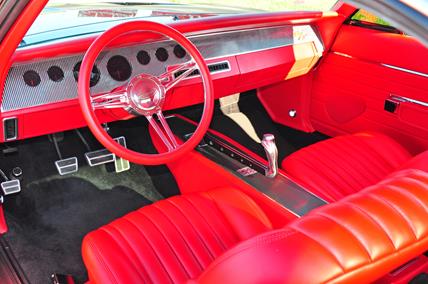
Dash is a one-piece billet unit that pays homage to the original design, and is filled with Autometer dials. Custom shifter instructs a Keisler 5-speed.auto.Switch under the driver’s seat operates exhaust cutouts. Budnik supplied the wheel.
The rear lip spoiler is likewise hand-fabbed. The rear bumper started out as a stock piece. But it proved so much trouble to modify for the right look, that when it came time to do the front bumper, Rock just handmade a whole new piece. In fact, much of the front of the car is new. The hood is not new, but its inner structure was changed to accommodate the intake tract.
Let’s step inside the Charger, shall we? But first you gotta remove your shoes. There’s little original left here, as well, but Boldry did want to preserve the feel of the 1969, so it could be appreciated by those visually Challenged who get the Mopar Action Braille edition Credit for all of it goes to Don Kite, who crafted the one-piece billet dash patterned after the original panel. The Auto Meter Nexus gauges have a smoked look (the look varies depending on what you’re smoking.)
The one-piece custom-made shifter hides a line lock switch. The wheel is a Budnik. Front seats came out of a Mazda, and the rear seat is custom made. A combination of LizardSkin ceramic spray-on insulation and Dynamat make the Charger almost as quiet as a Lexus with the motor turned off – until Boldry pushes a switch under the driver’s seat to open the exhaust cutouts.
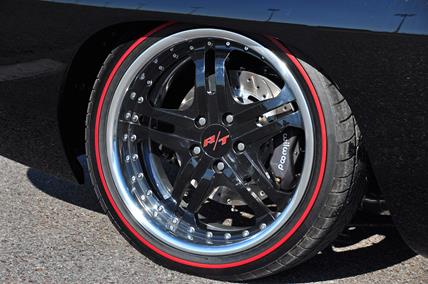
Boze ZE forged “Friction” wheels roll with custom fabbed R/T center caps.
The whole project, from that initial K-frame to the DuPont black paint, took two and a half years. Naturally, all of this custom fabbing and add-ons have added quite a bit of weight to the Charger, which started out fairly porky to begin with. Boldry didn’t reveal the weight, but he does have plans for another accessory. Once he adds a clear bra (yeah, we giggled, too), he plans to drive the car a lot more.
Hey, maybe we’ll put a clear bra on our padded-roof Omni Brougham and drive it some more. Or maybe on our tech editor for a centerfold photo in our annual X-rated issue.

